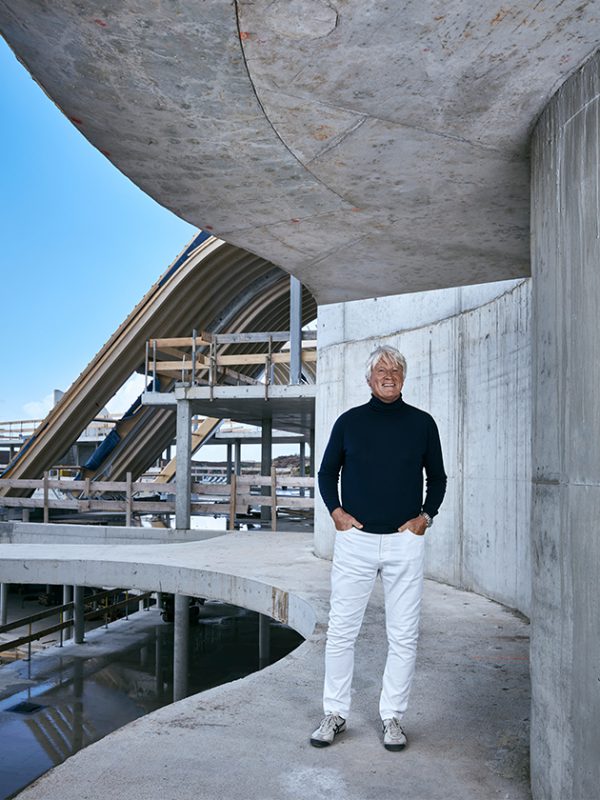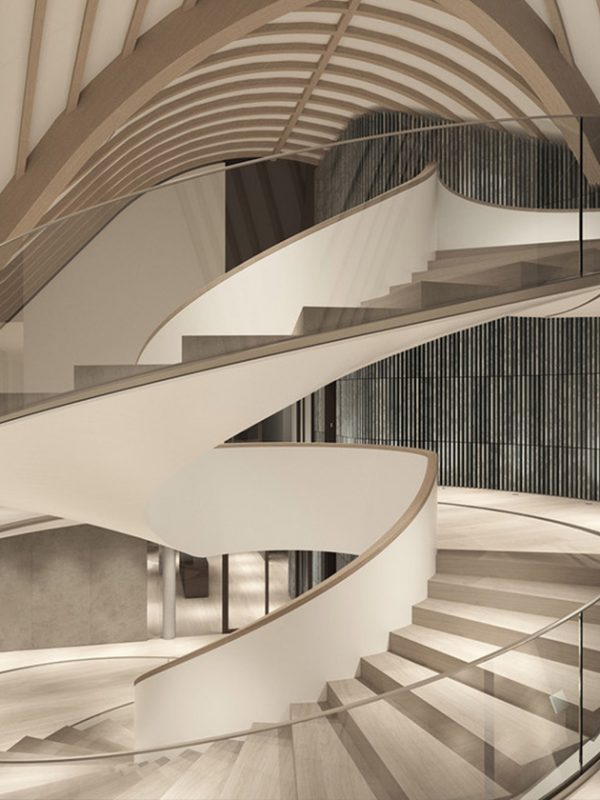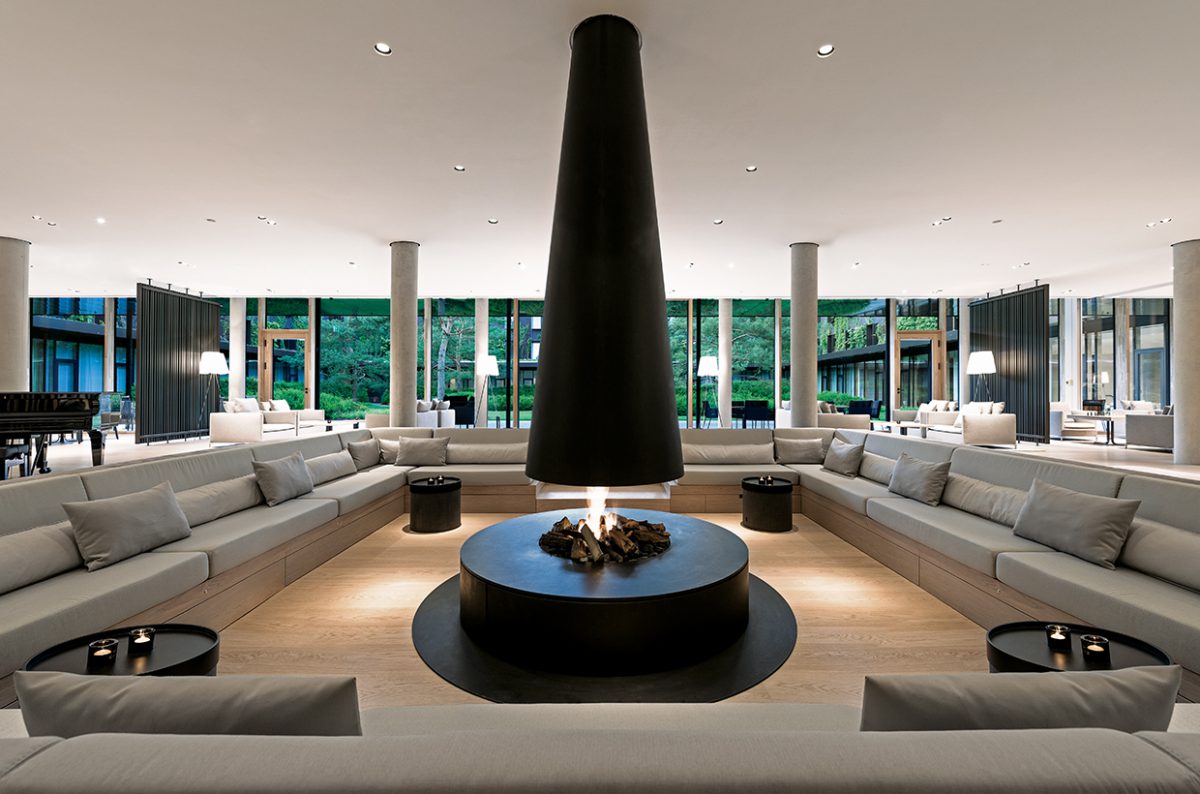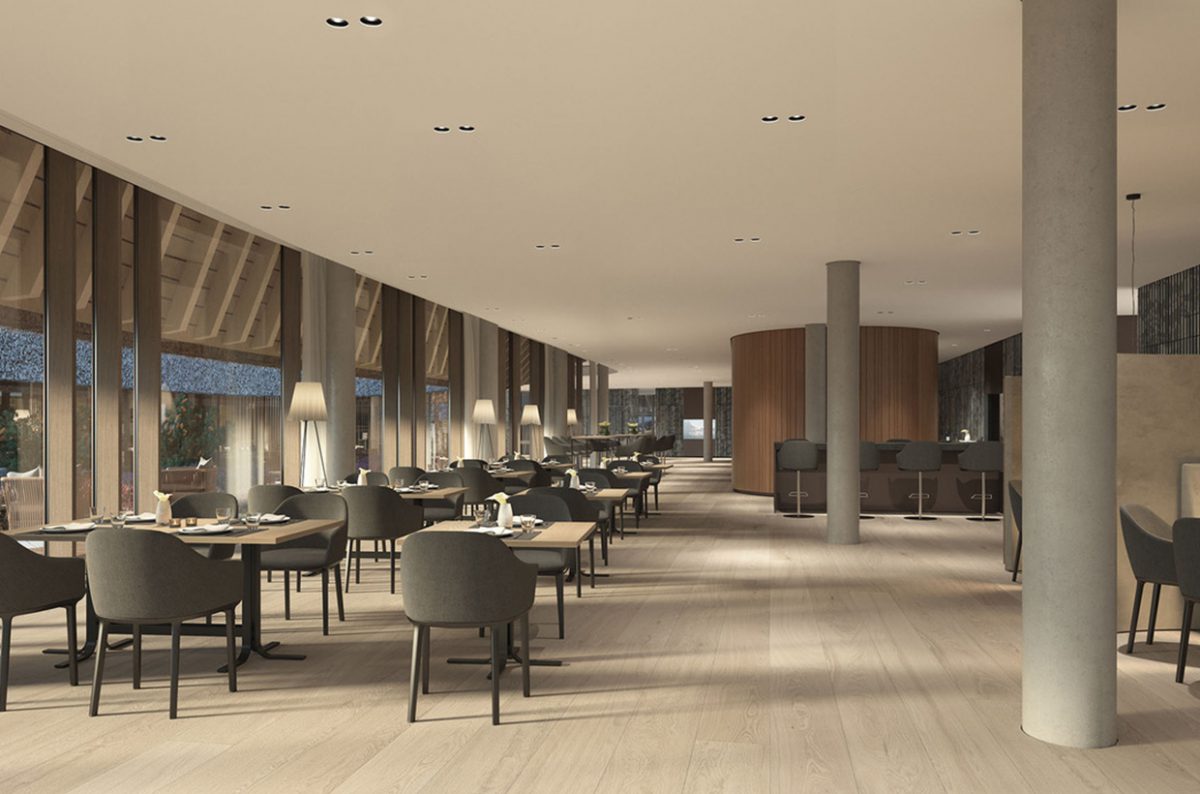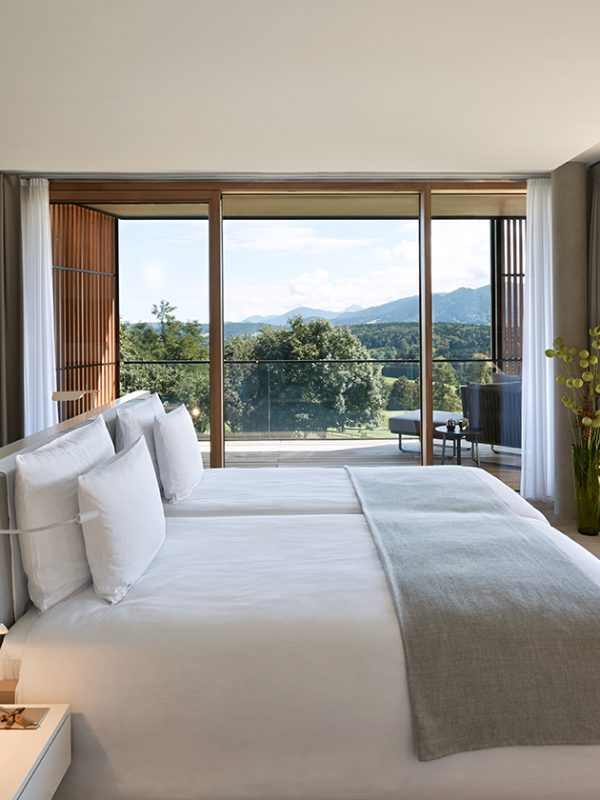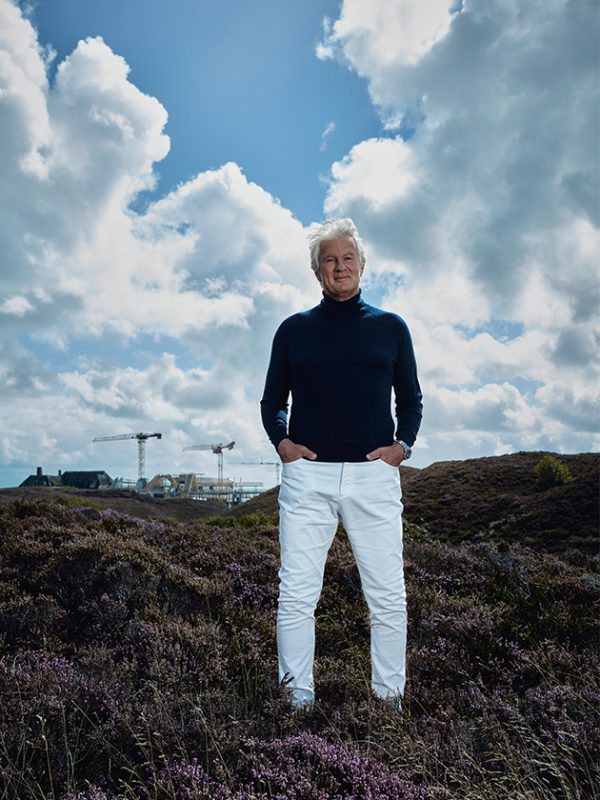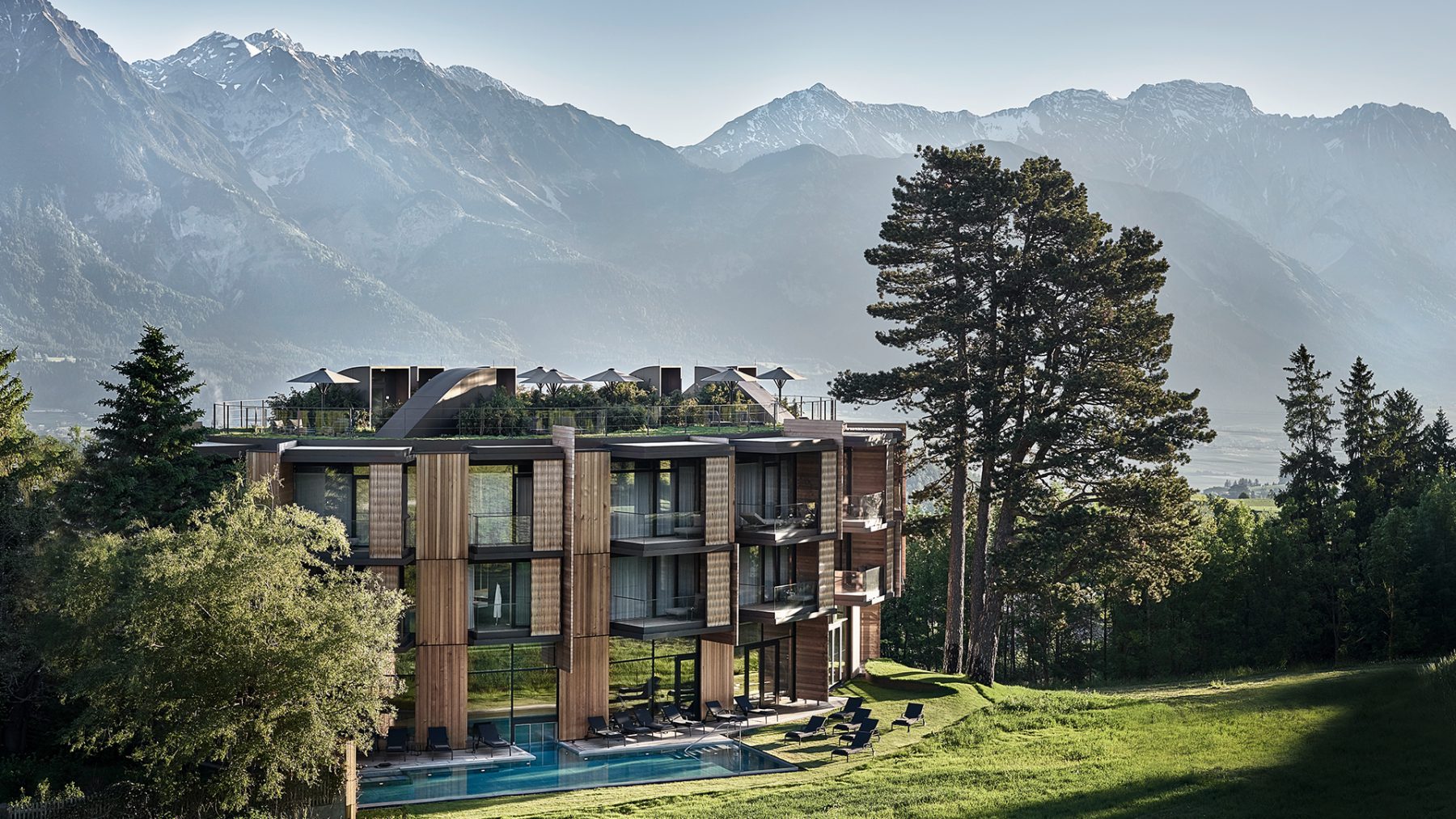Lanserhof by Michaela Cordes | 4th December, 2020 | Personalities
Does architecture have healing powers? Guests at Lanserhof health resorts enjoy the tranquility of minimalist surroundings with all their senses. Each Lanserhof location specializes in regenerative intestinal cleansing and is focused on preventive
medicine. Surrounded by natural wood, organic hues and walls devoid of artwork, the gaze is drawn toward the outdoors. German architect Christoph Ingenhoven is responsible for the soul-soothing aesthetics.
Having trademarked Lanserhof locations in Tyrol, Tegernsee, Hamburg and London, the Düsseldorf native is now working on the most elaborate Lanserhof medical spa to date, on the North Sea island of Sylt.
Mr. Ingenhoven – You’re currently creating Lanserhof number five. How did you become the architectural mastermind behind the worldrenowned medical resorts?
Christoph Ingenhoven: The collaboration began in November 2011. I had been to Lanserhof as a guest several times already and one day I received a phone call from Christian Harisch, owner of the Lanserhof Group, who said he had come across a newspaper article about our firm while waiting at the airport in Athens. He was looking for an architect for his new project on Lake Tegernsee. We opened two years later, after just 24 months of planning and construction. We then extended and remodelled the original Lanserhof in Lans, Austria, and opened Dover Street, a joint venture between Lanserhof and The Arts Club in London in the summer of 2009. At present, we’re building a resort on the island of Sylt that is scheduled to open in the middle of 2021. A new kind of Lanserhof location in Hamburg’s HafenCity district is also in the planning stages. Beyond that, we have many ideas for future collaborations, some of them quite unconventional. We’ve considered locations from the Mediterranean to Asia, Malibu and Montauk have also been floated, but we have to make sure we don’t overextend ourselves. Such projects involve an immense amount of work for both Christian Harisch and myself, so we have to choose carefully.
The first Lanserhof was built as a hotel back in 1974 and from 1984 onward, became one of Austria’s leading medical resorts. In 1998, Lanserhof was taken over by the entrepreneurs Anton Pletzer and Christian Harisch, who were joined by Stefan Rutter in 2009. Over the years, the Lans Med Concept was developed based on the philosophy of Dr. FX Mayr’s therapeutic approach, as was the Energy Cuisine nutrition program. The Lanserhof building on Lake Tegernsee in Bavaria looks a bit like a modern-day monastery. Is that the type of architecture that inspired you?
You could say that. The two main types of large architectural structures traditionally found between the lakes and snow-capped peaks of the Alpine foothills are monasteries and farmsteads. Both types of buildings are organized around a central courtyard that shields residents from the wind and the cold. The monks who once lived on the Steinberg hill above Lake Tegernsee were pretty isolated. The three-story Lanserhof project we built there measures 70 by 70 meters and has a combined area of about 17,000 square meters and 70 rooms. So it is somewhat similar to a monastery. This was actually quite apt because during a course of treatments, you lead a rather monastic existence. When you’re hungry all the time, you may not feel great and even get a bit bad tempered. I always say that if you go to a medical spa as a couple, your relationship had better be strong because otherwise, the discomfort caused by the detox might bring on a relationship crisis (he laughs). But once you’ve survived the first few days, your energy will return and you’ll feel refreshed and cleansed. Guests really put in an effort to get to that point.
The Lake Tegernsee location seems better suited for couples than Lans in Austria, because its layout is so much more spacious.
Space is definitely a luxury we can offer guests at Lake Tegernsee. There’s very little in the way of food and since alcohol, cigarettes and sugar are banned, you can’t attract customers in the usual way. Space does affect a person’s well-being. Many guests might feel like they need to be by themselves and take a break from everything. When the treatment begins, people often feel cold more quickly than they normally would, because they have less energy. So they need something to warm them up. And there’s no better way to do that than sitting out in the sun. People also sleep outside during the day. They generally sleep more than usual, anyway. That’s all part of the detox. It’s quite a grueling process.
“I see my role more as someone
who supports a constructive
collaboration.“ CHRISTOPH INGENHOVEN
How do you take this into account architecturally?
Every room, even the bathroom, has a loggia, so you can sit or sleep outside any time you wish, away from prying eyes and sheltered under a roof. We used this design for the bathhouse in Lans and we’re using it in Sylt as well. Each guest has their own small outdoor space, a kind of private terrace that’s integrated into the thatched roof. It works very well and since it’s closed on three sides, it allows guests a bit of privacy. In Sylt, you look straight out onto the sea or the dunes from these private terraces. At the Lanserhof Tegernsee, you get a lake view. That’s how we create a bit of spatial luxury.
To what extent do the materials you use support the detox process?
We maintain a connection to nature even though guests spend a large amount of time indoors, undergoing checkups and treatments and engaging in various activities such as physical exercises and swimming. By the way, we have an outdoor saltwater pool that is open all year round. We also wanted to ensure that being indoors doesn’t stop guests from venturing out if they wish. The view of the outdoors is unobstructed. There is ample space and we used a lot of glass. You can just open the door and be outside. Another thing that was important to us: Guests at a medical spa don’t want to be confronted with the temptations of life outside. The Lanserhof Tegernsee is in the middle of a golf course, but you will never see any of the golfers. We wanted to ensure that nobody walking by would suddenly unwrap a sandwich and start eating in front of the guests. Our guests also shouldn’t have to deal with food smells like those from a kitchen. The scent of a frying schnitzel wafting on the wind? No, thank you. We make it possible for guests to cocoon within their private quarters too. At 54 square meters, even the smallest rooms are quite sizable, with plenty of space to move around. The same goes for the common areas, so keeping a safe distance from others during the current coronavirus pandemic is not an issue at all. It helps, of course, that Lanserhof resorts are also medical facilities that meet all the standards required of any licensed clinic. So we have been able to remain open. Neither the restaurant nor the patio are ever really crowded, and the lounge is vast. In fact, everything at Lake Tegernsee is spacious. And all the features are exactly what they appear to be. What looks like wood is actually made of wood, the same goes for metal elements. We don’t disguise anything with siding or paneling, it’s all authentic. In other words, everything has been reduced to a reasonable minimum. We like to say: “The way we build, anything you take away will leave a gap.”
What was your personal source of inspiration while developing the Lanserhof concept? Did you create a kind of architectural corporate identity?
The architecture of each building is inspired by its location. This means we take into account everything from traditional building styles to valuable input we receive from local people about the climate or the availability of particular materials. It’s our job to come up with a contemporary or even radically new interpretation. We use healthy materials that don’t give off any toxins and prefer light-colored oak floors, white ceilings and fabrics in natural hues. No decorations, no art, but instead gold-colored curtains. Simple, modern furniture created by excellent designers such as my friend Antonio Citterio. All the gardens are designed with the help of my friend Enzo Enea. We spend quite a bit of money, in fact, but not in an obvious way. We use fine materials, but we don’t splurge unnecessarily. Moderation is the word that best describes our approach.
“We’ve been building sustainably for
30 years, but the pandemic has boosted
public awareness.” CHRISTOPH INGENHOVEN
That all fits in very well with a new awareness created by the pandemic. We don’t need all that much to be happy. But you have actually been applying this soothing, minimalist approach for years already when designing Lanserhof interiors.
For me as an architect, it’s an important philosophical and personal consideration. Take the sailboats competing in the America’s Cup, for example. They have been stripped of everything but the bare minimum required for sailing. You could never convince one of those sailors to add an extra coat of paint, let alone any kind of decorative element. Every ounce has to be accounted for. And once these boats have been refined to the point where they are ready for racing, they have become quite stunning. How can something without a single frivolous element be so beautiful? It’s exactly that which makes them so perfect. We can only say we’re finished with a building when there’s nothing more to eliminate. Like a painter who has to know exactly when a work of art is finished. It’s not easy.
Has this minimalist aesthetic always been part of your philosophy, or did you develop it while working on the Lanserhof projects?
I’ve always adhered to this philosophy, but its nature has changed slightly since I started doing work for Lanserhof. A medical spa is a typical place for a staycation. People don’t just come for a short period of time, they might spend ten days or two weeks, maybe even longer. And many return year after year. That’s why the architecture has to be able to stand the test of time. It has to have something timeless about it so that people won’t get tired of looking at it after ten or even 20 years. You also have to consider things like sustainability and health implications. All of the materials and all the building sites are inspected by building biologists, who are experts in spotting environmental hazards, and by diviners, who are knowledgeable about magnetism.
You do all of that as well?
Sure, we take it very seriously. There are many things that are impossible to prove. I’m not an expert on esoteric subjects but magnetic disturbance is something that can be measured and it’s important to take that sort of thing into account. We also always try to be responsive to the local culture when we build a new location. The Bavarian landscape is very grand and impressive and the local society is very much influenced by agriculture: The farmsteads are big, the lines of the buildings are stark and the untreated larch wood used in them turns gray as it ages and so blends in well with its surroundings.
What about in Sylt? The Frisians seem to be a unique sort of people.
Yes, the situation is quite similar. Those seafaring and salvaging Frisians! They didn’t give us an easy ride in Sylt. We encountered a fair bit of healthy skepticism toward outside investors, but I found people to be very helpful and have even made some friends. People were very welcoming, but it was extremely difficult to get construction permits. In fact, all of our sites have been very complicated in this regard. The regular building code doesn’t apply in Sylt. The site that we were looking at had buildings on it dating back to 1934 that had been built to accommodate German naval officers. At the time, it was evidently thought that Germany needed to be prepared for a possible attack from Denmark, and so thousands of navy personnel were stationed on Sylt. The style of these buildings was the typical local design mixed with “blood and soil” architecture – houses with thatched roofs and columns rising up in the front. It actually makes you wonder exactly what was going on there. The whole site was a designated landmark. Environmental laws also protected the coast, the dunes and the birds.
That’s crazy! It sounds like you were faced with quite a few challenges.
We had to weigh up all of these environmental objectives against the politically backed desire for a showcase project. In the end, we were granted the necessary permits and were able to replace some of the buildings with new ones, several of them the same size, others larger than the previous ones. Currently, we are restoring the main building. We only add to it where it is damaged. We were also permitted to knock down one of the dormitories and construct another building that was considerably larger. This will serve as the main building of the Lanserhof complex. We proposed a structure with a thatched roof, which to me was a fascinating prospect. I had always wanted to use water reeds as a building material because it allows you to create free-flowing forms. We went ahead and designed the building in the style of a Frisian house. The Frisians traditionally only built a single, low-ceilinged story above the ground floor. When you look at the houses from a distance, you see the dunes seemingly merging with the roofs to create a harmonious whole. And that’s what we’re doing too.
“When there’s nothing left to eliminate, that’s when
our work is complete.“ CHRISTOPH INGENHOVEN
Healthy, sustainable construction is something you have been involved with for a long time. Your most recent project, which has just opened in Düsseldorf, is the Kö-Bogen II, an office and retail complex that features more than 30,000 hedge plants. It has been hailed as Europe’s largest green facade. Has COVID-19 increased people’s desire for healthy architecture?
Yes, real estate funds have been calling for buildings with environmental certification for quite a while, but people’s awareness of this subject has increased during the pandemic. The first thing you often hear from international corporations and large tenants is: “You do realize it has to fulfill the highest green building standards, don’t you?” Only then will they start talking to you. This has become standard during the pandemic, and the Fridays for Future climate strike movement has brought even more pressure to bear from the next generation.
You have five children – do you feel pressure coming from them too?
Yes, I have five of my own and my partner brought two more into the family. They are all between the ages of 18 and 32. I also have three grandchildren, so the pressure is considerable. This, although I have always considered myself somewhat of a role model (he laughs). But they always find things to complain about. They bombard me with questions and comments such as: “Are you vegetarian or vegan, or do you actually still eat red meat? You drive too fast! You’re driving the wrong type of car! You shouldn’t be driving a car in the first place,” or “What do you mean: You still travel by plane?”
Perhaps these are two separate things? Building sustainably, which is good for the planet, and doing things that are healthy on a personal level?
These days, you have to consider both the biological and the ecological aspects. Take polystyrene, for instance. It’s fine once it’s produced, but the manufacturing process is horrendous. So the same material that is perfectly safe for me as an individual is very bad for the planet. We have to take a holistic view. Sustainable construction, which is what our supergreen© trademark stands for, isn’t easy to define. We’ve been building sustainably for 30 years and have always tried to stay ahead of the curve. But what was innovative 20 years ago is standard today. So, things are exciting and a require a lot of hard work, but we’re still having fun.
You come from a family of architects. Did you always know that you would become one, too?
I was briefly tempted to study marine biology at one point but opted for architecture in the end. My father, my brother, my first wife and her father were all architects, which was a bit tricky. But I still opened my own studio at the young age of 25.
Have you ever been approached by a private individual and asked to build them a healthy house?
No, that hasn’t happened yet (he laughs). Over the course of my career, I have only built two single family homes. One of them was for a good friend – who, incidentally, is still a friend – and the other one was my house in the countryside near Düsseldorf. Actually, I’m currently building another house for my family in Engadin, Switzerland, so that makes three. We’ve turned down offers, of course. “Please ask me to build you a private home,” is not a message we put out to customers (he laughs). Economically, that would make things quite difficult for a big architectural firm like ours.
You are currently involved in projects around the world: in Germany, Japan, Hong Kong, Singapore, Australia, Switzerland and in the U.K. How many people do you employ at your office in Düsseldorf?
Right now, we have around 125 people working on over 40 projects in Düsseldorf and Singapore. The teams who work on each project range in size from two to 20 people. Each year, we also take part in around 20 competitions.
Which other architects have inspired your work? Who do you particularly admire?
Richard Neutra, Charles Eames, Albert Frey, John Lautner, Frei Otto, Jørn Utzon, Glenn Murcutt – it’s a very long list. In fact, the type of architecture I admire most was usually not designed by architects at all – buildings like farmhouses, barns and tents. Rather than by any particular style, I’m most impressed by open, experimental and non-deterministic approaches. I have a lot of time for people who sometimes find themselves trying to find a balance between popular, elitist and intellectual approaches.
“Building houses with thatched roofs like
in Sylt is something I’ve always been
dreaming about.“ CHRISTOPH INGENHOVEN
In an interview, Frank Gehry once told me that he thought of himself more as an artist, rather than an architect, and that he felt misunderstood and shunned by the architectural community. Richard Meier, on the other hand, sees himself as an architect first and doesn’t wish to be regarded as an artist. How do you see yourself?
That’s not something that overly concerns me. I am most definitely not the kind of architect who feels driven to reproduce more or less the same thing no matter where I am. To me, that’s an outdated concept and it’s not what we need going forward. I see myself as a contributor to an ongoing project, namely that of making the world more comfortable for those who inhabit it. Perhaps we need to define comfort differently, though. It’s very important to be able to express oneself well, in an architectural sense. It’s important for us to be able to explain what we do and to enter into a fruitful dialogue about our work. Many people think that if something cannot be explained, it is a sign of quality. That’s utter nonsense as far as I’m concerned. The age of the individual designer in their ivory tower is over. What we urgently need is an open and honest dialogue, as well as verifiable and explainable approaches.
You live and work in Düsseldorf. The Dusseldorf School has produced some very interesting artists and personalities. Sitting in your office today, can you still feel the energy?
Yes! The city’s cultural scene is very much alive: Marius Müller-Westernhagen, Die Toten Hosen, Kraftwerk, Wim Wenders, Zero, Charles Wilp, Immendorff, Lüpertz, Richter, Beuys, Düsseldorf’s many photographers, and the list goes on. The Rhineland region of Germany is culturally very different from the rest of the country. There’s a strong Romance, specifically French, influence. Not just because of its occupation by France after World War I or because Napoleon ruled it for decades. It was a Roman colony for 400 years. We also have a symbiotic relationship with the Netherlands, Belgium and Luxemburg, which has shaped us. There is an openness and a liberalness here that makes it easy for our employees, who hail from all over the world, to feel at home.
“The Fridays for Future movement has put the next generation
under enormous pressure.“ CHRISTOPH INGENHOVEN
Do you collect art yourself?
Yes, I’m something of a collector of photographs, which probably makes sense for someone from Düsseldorf. I was once offered a seminal photograph by Thomas Struth in lieu of a rent payment. After that, there were further rent payments in the form of paintings. But as I didn’t particularly care for them, I swapped them for photographs. This ignited my enthusiasm for photography. It had always interested me, but never that strongly. I’m not a big collector really, but I do enjoy the art form. I like the large-format works by the famous Düsseldorf photographers: Andreas Gursky, Thomas Ruff, Thomas Struth, Axel Hütte. I’m also a big admirer of American photography (and literature) – people like Stephen Shore, Saul Leiter, Richard Prince and Irving Penn. I have a very particular taste. Irving Penn was a famous fashion photographer, but I collect his pictures of flowers. I also collect some of Hiroshi Sugimoto’s work – a Japanese photographer who mainly took pictures of the ocean. I also take an interest in Nobuyoshi Araki’s photographs of flowers. For a while, I collected political photojournalism and still do. These days it’s no longer easy to find outstanding works, like those of Robert Capa, who photographed the Spanish Civil War and the Allied landing on Omaha Beach in Normandy. Or works by Josef Koudelka, a Czech photographer who documented the Russian occupation of Czechoslovakia. Or the photos of the Vietnam War, the assassination of Robert Kennedy and many other such events. I only collect things that affect me on a personal level and only when I can get hold of an extraordinarily good print. It’s all terribly subjective and requires a certain amount of investigative effort on the part of the collector to familiarize themselves with what’s available and where to find it. But I’m learning.
One last question: What dream building do you still want to turn into reality? As an architect who builds skyscrapers, I would naturally love to build one in New York City – that would be the ultimate accolade. But New York is a city that is dominated primarily by money and profit, so it doesn’t necessarily produce the best architecture. Our projects require a lot of care and painstaking attention to detail. It would be difficult to use this approach in a city that has such a money-driven attitude to construction. We haven’t had any offers to build anything in New York as yet, but who knows, maybe one day we will.
